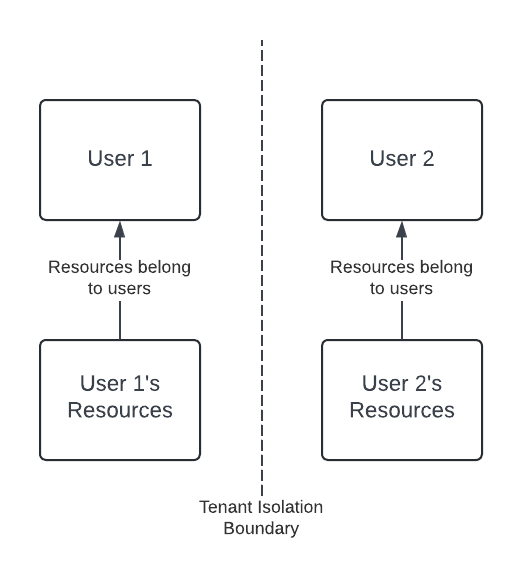B2B multitenancy in Tesseral
Tesseral is auth infrastructure specifically for B2B SaaS. That means it has B2B multitenancy built-in. This article explains what multitenancy is, and how B2B multitenancy works differently from B2C multitenancy.
What is multitenancy?
In the context of software-as-a-service (SaaS), customers are also called “tenants”. “Multitenancy” means that one application serves many customers, instead of having a separate deployment of your application for each customer.
When you implement multitenancy, you need tenant isolation. That refers to the idea that one tenant can’t see another tenant’s data.
There are two kinds of SaaS products, and they each have their own tenancy model: Business-to-Consumer (B2C) and Business-to-Business (B2B).
B2C multitenancy

In B2C, you sell your software to individuals. E-commerce (Amazon, Walmart), entertainment (Netflix, Spotify), and personal development (Strava, Duolingo) products are mostly B2C.
B2C tenant isolation is around users. A user can see their own data, but they
can never see other users’ data. To make that work, most data in a B2C product
exclusively belongs to a particular user (e.g. it has a user_id property in
the database).
B2B multitenancy

In B2B, you sell your software to businesses. CRMs (Salesforce, HubSpot), cloud vendors (Amazon Web Services, Azure), and HR software (Workday, Rippling) are mostly B2B.
B2B tenant isolation is around organizations, and users live inside
organizations. Users can see their own data and the data of other users in their
organization, but not data outside their organization. To make that work, most
data in a B2B product exclusively belongs to an organization (e.g. it has a
organization_id property in the database).
This article uses the word “organization”. Other products have a different name for the same concept. Synonyms include “workspace”, “team”, or “company”.
B2B multitenancy introduces complexities:
-
Users need to be able to invite coworkers to join them. B2B products need to support user invitations.
-
Businesses have compliance requirements around how their employees log into software. Customers will ask to customize their login methods, such as disabling passwords, or requiring MFA, for their organization.
-
Businesses want to be able to configure SAML or OIDC, and to make it the exclusive login mechanism for their organization.
-
Businesses want to be able to create, update, and delete their users programmatically using SCIM.
-
Businesses want to be able to configure Role-Based Access Control so that users only have the permissions their job requires.
Tesseral is designed to support all of these complexities head-on, giving your product a simple way to implement all of this functionality at once.
How multitenancy works in Tesseral
Tesseral is built around the B2B multitenancy model. In Tesseral, each of your customers corresponds to an Organization. Users exclusively belong to Organizations; every User belongs to exactly one Organization.
Organizations come pre-built with support for User Invites, Roles, SAML Connections, OIDC Connections and SCIM API Keys. Owners of an Organization can restrict the set of login methods they want their Users to authenticate with, and can require MFA. UIs for all these settings are prebuilt as part of Organization self-serve settings.
When you implement
Tesseral, you get all of
this functionality without writing any code. From your backend, you can always
extract an
organization_id from
any authenticated request, and know that Tesseral has already implemented all
the logic to make that login legitimate for that Organization.